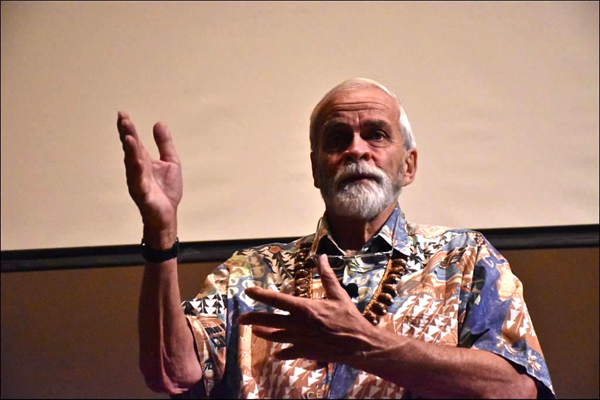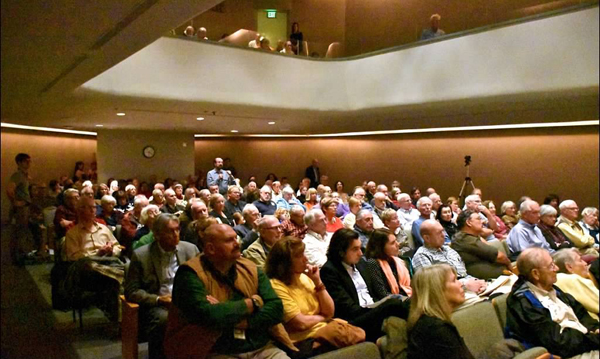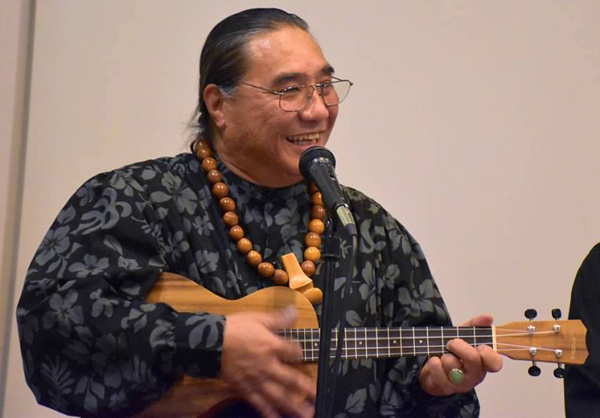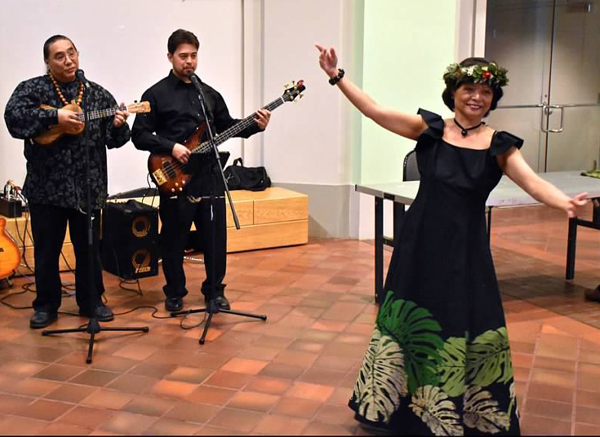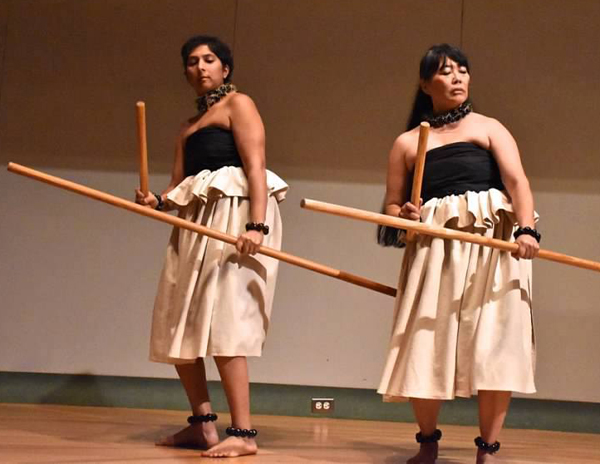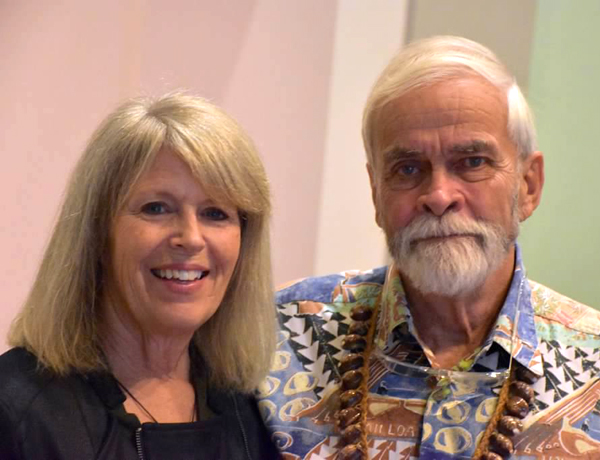Class News
Sam Low '64 speaking about Hōkūle‘a's worldwide voyage
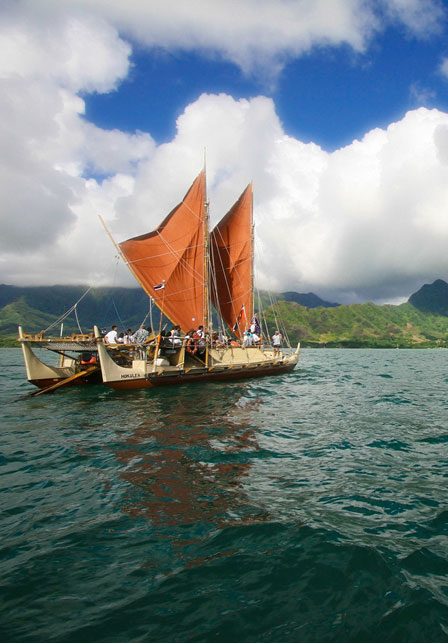
Sam Low was joined by Kumu Manu Ikaika and his dance organization Halau Ho'omau I ka Wai Ola O Hawai'i along with Smithsonian Senior Geographer Douglas Herman at the Smithsonian's Ripley Center on November 2, 2015 for a presentation of Sam's film The Navigators and a discussion of Hōkūle‘a's Malama Honua Worldwide Voyage. See The Navigators here.
The house was packed with people eager to learn more about Hōkūle‘a and her mission. Sam was introduced as "an internationally-acclaimed writer, photographer, educator, producer, Polynesian navigation enthusiast, and supporter of the Hōkūle‘a and Hikianalia" (two replica Polynesian voyaging canoes).
Hōkūle‘a and Hikianalia are sailing across the world's oceans to join and grow the global movement toward a more sustainable world. Their worldwide voyage began in 2013 with a sail around the Hawaiian archipelago, and will continue through 2017 when a new generation of navigators takes the helm and guides Hōkūle‘a and Hikianalia back to Polynesia after circumnavigating the globe. The Hawaiian name for this voyage, Mālama Honua, means “to care for our Earth.”
Photographs of the Smithsonian event (taken by Paul Ruden '64) are appended at the bottom of this page. This event is one of many in an extensive tour to publicize the worldwide voyage. Other events included:
The Mariners' Museum & Park
Newport News, Virginia
Thursday, November 5, 7:00 to 9:00pm
Virginia Aquarium & Marine Science Center
Virginia Beach, Virginia
Sunday, November 8 at 2:00pm
The College of William & Mary
200 Stadium Drive, Williamsburg, Virginia
Tuesday, November 10 at 5:00pm
Virginia Institute of Marine Sciences
Gloucester Point, Virginia
Thursday, Nov 12, 7:00 to 8:30pm
North Carolina Maritime Museum
315 Front Street,
Beaufort, North Carolina
Friday, November 13 at 7:00pm
The New York Times wrote as follows about the tour.
A Hawaiian Canoe Crosses the Oceans, Guided by Sun and Stars
The New York Times
November 2, 2015
It’s likely to cause a few double takes, even among seen-it-all New Yorkers.
Next June, a working replica of a traditional Hawaiian voyaging canoe — 62 feet long, double-hulled, with two powerful crab-claw sails — will make its way down the Hudson River, one small leg in a three-year journey.
In a nod to their seafaring ancestors, the crew of 13 will forgo modern navigational equipment — no compass, sextant, or GPS devices, not even an iPhone — in favor of wayfinding, a traditional navigational technique that relies on gauging the position of the sun, moon, and stars, taking into account variations in ocean currents and wave patterns and even the behavior of fish and birds.
The canoe, known as Hōkūle‘a (“star of gladness”), was built in 1975 by the Polynesian Voyaging Society to promote Hawaiian indigenous culture, in particular the voyaging and navigational traditions that brought Polynesian settlers to the Hawaiian archipelago. Its inaugural voyage in 1976, from Hawaii to Tahiti, was a 2,500-nautical-mile journey marked by a raucous arrival in Papeete Harbor in front of 17,000 people, according to the Society.
Since then, the canoe has been traveling around the Pacific trying to help settle the debate about the origins of early Polynesian settlers. In his 1947 Kon-Tiki expedition, the Norwegian explorer Thor Heyerdahl sailed from South America to Polynesia on a raft with no modern navigational equipment to demonstrate that South Americans could have settled Polynesia the same way. Heyerdahl’s hypothesis was never embraced by most scholars; still, Hōkūle‘a has proved Polynesians were more than capable of the feat.
“Polynesia was not settled by landlubbers who drifted haplessly with the prevailing winds and currents from South America on primitive rafts, but by real seamen who ventured out into the ocean void at about the time when the walls of Troy were falling to the Greeks,” the Hawaiian author Sam Low wrote recently.
Last year, Hōkūle‘a embarked on a new journey, with a more urgent purpose: a three-year circumnavigation of the globe — more than 60,000 nautical miles — with events along the way aimed at drawing attention to the effects of climate change on the oceans.
Leading the expedition is Nainoa Thompson, the president of the Polynesian Voyaging Society and one of just a handful of navigators trained in wayfinding. Born in Hawaii, Mr. Thompson went to college in Oregon before returning home to join the first Hōkūle‘a crew. When Hōkūle‘a first set out in 1976, it was thanks to Mau Piailug, a seafarer from a small Micronesian island called Satawal who had taught Mr. Thompson the old ways.
“It was a long trip, 31 days, and there were a lot of unknowns,” Mr. Thompson recalled during a recent visit to New York to drum up support for Hōkūle‘a’s journey. “None of the crew members knew each other, and no one really knew what was going on.”
On his first day, Mr. Piailug took stones from the garden and made a map of the stars on the ground, Mr. Thompson said. Slowly, he learned to pay attention to ocean currents and read the weather from the color of the light at dawn.
Since then, he has guided the canoe on six major voyages totaling more than 140,000 nautical miles, inspiring a revival of canoe building and wayfinding. According to the Polynesian Voyaging Society, there are now 25 deep-sea voyaging canoes in the Pacific, and more than 2,000 active voyagers from 11 Pacific Island nations.
Mr. Thompson spent six years repairing Hōkūle‘a and training 350 crew members in preparation for the canoe’s global voyage. (At any given time, Hōkūle‘a has 11 to 13 crew members aboard who rotate in and out every four to six weeks.) In particular, he focused on passing on the core concepts of traditional wayfinding to younger crew members who he believes will be committed to sharing them with the next generation.
One of those is Jenna Ishii, a 29-year-old apprentice navigator who also works as an education coordinator for the Polynesian Voyaging Society. On training sails, she said, Mr. Thompson teaches apprentices skills like how to stand and sleep simultaneously — “he will stand up and put his hands on the railing with his elbows locked so that he can sleep for a few minutes at a time,” she said — and how to observe the ocean and the sky for cues.
“Nainoa says that a navigator will make over 1,000 observations a day, and make two key decisions — at sunrise and sunset — about how far you have gone and where to go next,” Ms. Ishii said. This includes plotting a course that will ensure the canoe travels upwind for most of the journey before switching to downwind to reach its destination, avoiding what is known as tacking — sailing back and forth against the wind.
While the crew aboard Hōkūle‘a will, for the most part, use wayfinding techniques, the canoe is equipped with modern instruments in case of emergencies, and to navigate around more dangerous straits and channels, like the Mozambique Channel and the Cape of Good Hope in South Africa.
“If we can navigate without them, we will,” Ms. Ishii said. “But if the weather compromises us, or it becomes an issue of speed, we will use instruments.”
Crew members document their days at sea, blogging and posting videos. The Hōkūle‘a website has a live tracking map showing the location of each canoe and its intended path around the world, but crew members are forbidden to consult it. Sometimes, crew members invite students to participate in Google hangout sessions, in which the students are under strict orders not to reveal the exact position of the canoe to the crew. Even watches are strictly forbidden onboard, because they can be used to determine speed.
Has any crew member ever been tempted to simply Google Hōkūle‘a’s position?
“You’re so committed to the journey that it would be a shame,” Ms. Ishii said. “No one will break tradition.”
Mr. Thompson added: “To be given information would be an insult. It takes away the challenge.”
Still, slip-ups have been known to happen. Navigators are no longer allowed to be the primary communicators on the canoe, but Ms. Ishii remembered a radio transmission in which the operator had innocently announced the canoe’s position.
“It makes you want to cry,” she said.
Photographs of the Smithsonian event
Courtesy of Paul Ruden '64
